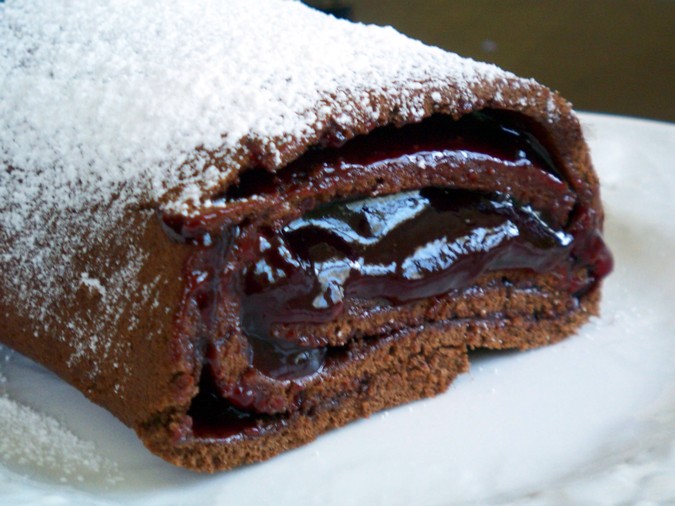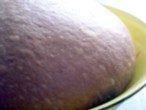A warm, airy pudding in which the flavors of chocolate, hazelnuts and caramel combine in perfect harmony. A nice dessert for snowy, wintry evenings.
 This is my entry for Sugar High Fridays #38, hosted this time by Zorra who proposed a wonderful theme: Pudding
This is my entry for Sugar High Fridays #38, hosted this time by Zorra who proposed a wonderful theme: Pudding
Here is the ROUNDUP
Steamed puddings are old-fashioned desserts that, when made properly, have a feathery light, spongy texture. For perfect results, here are a few simple rules to remember–in the words of Marion Harland from her book Common Sense in the Household (1873):
♦ The water must be boiling when the pudding goes in, and not stop boiling for one instant until it is done. […]
♦ The water should not quite reach to the top of a mould. […]
♦ When the time is up, take mould […] from the boiling pot, and plunge instantly into cold water; then, turn out without the loss of a second. This will prevent sticking, and leave a clearer impression of the mould upon the contents.
♦ Boiled puddings should be served as soon as they are done, as they soon become heavy.
There are special moulds for steamed puddings, which are provided with a lid that can be closed tight. However, a regular pudding mould, a large pyrex bowl, or even a clean coffee can all work fine, if they are covered with a piece of aluminum foil secured with string. This method sounds more complicated than it really is, and the results are truly worth it. The batter could be baked in an oven, but the pudding will not have the same moist and light texture.
From the original recipes by Maria Willett Howard
In: Lowney’s Cook Book, 1912–USA
Ingredients
2 tbsp (30 g) butter
1/4 cup (30 g) flour
1 oz. (30 g–1 square) unsweetened chocolate, grated (I used 85% bittersweet chocolate)
1/4 tsp (1.5 g) salt
1/2 cup (240 ml) milk, scalded
5 eggs, divided
3/4 cup (150 g) sugar
1/2 cup (100 g) toasted hazelnuts, finely chopped (Almonds, walnuts, and pecans work equally well in place of the hazelnuts)
Caramel Sauce
1 cup (200 g) sugar + 1 cup (240 g) boiling water
Make the pudding: Melt the butter in a saucepan, then add the flour and mix well to avoid lumps; add grated chocolate and salt, stirring continuously and add scalded milk in a thin stream stirring well. Cook the mixture for 5 minutes on very low heat then set aside to cool. Meanwhile beat the yolks till light and pale yellow, adding sugar little by little, then add hazelnuts and stir well. When well blended, add the chocolate mixture to the egg mixture and mix well. Beat the egg whites till firm and glossy, then fold them into the chocolate mixture, using a spatula. Be careful doing this last operation, to avoid deflating the egg whites.
Generously grease a pudding mould (2-quart–2 l capacity) or 10-12 individual ramekins with melted butter or vegetable oil. Grease also the pudding lid or the piece of aluminum foil that will cover the top of the mould(s) if you don’t have molds with a lid. Fill the moulds no more than 3/4, cover with lid or foil. Secure the foil with an elastic band.
Place a rack or trivet in the bottom of a pot deep enough to contain the mould(s), lower the mould(s) into the pot and add enough boiling water to reach half-way up the sides of the mould(s). Keep extra boiling water ready in case it is necessary to add more to the pot while the pudding is steaming (check often). Cover the pot with its lid with a weight on it to prevent the steam to escape.
Put the pot on high heat until the water starts boiling again, then lower the heat to keep the water simmering and steam the pudding. When the time is up carefully lift the mould out of the pot, plunge it in cold water, immediately unmould the pudding and serve.
To make this recipe this time I have used 10 individual deep ramekins, each of them covered with a piece of aluminum foil secured with string. I had to use two pots to steam all the puddings, and I let them boil for 50 minutes. If you use a single large mould, the pudding will have to steam for at least 1 hour and 45 minutes. A longer steaming time does not affect in any way the final result.
Caramel Sauce
Caramelize sugar in a deep saucepan. When it acquires a nice golden brown color, carefully add the boiling water, stirring vigorously to dissolve the lumps that will form. Simmer 15 minutes on low heat, then take off the heat and immerse the bottom of the pan in cold water to stop the cooking. The sauce is ready to pour on the pudding as soon as the pudding is unmolded.
P.S. Steamed puddings are always served with a sweet sauce.

 As the guest host of the 50th edition of Sugar High Fridays, the blog event dedicated to sweets founded by Jennifer of The Domestic Goddess I proposed Rolled Cakes as a theme. My own take on this is from the old classic Italian cook book La Scienza in Cucina e l’ Arte di Mangiar Bene—published in 1891—written by Pellegrino Artusi. It is a sponge cake flavored with bittersweet chocolate, to which I added a simple filling of seedless raspberry jam and a sprinkle of confectioners’ sugar on top. The final result is a pleasant dessert in which flavors and textures combine perfectly, and that is also quick and easy to assemble.
As the guest host of the 50th edition of Sugar High Fridays, the blog event dedicated to sweets founded by Jennifer of The Domestic Goddess I proposed Rolled Cakes as a theme. My own take on this is from the old classic Italian cook book La Scienza in Cucina e l’ Arte di Mangiar Bene—published in 1891—written by Pellegrino Artusi. It is a sponge cake flavored with bittersweet chocolate, to which I added a simple filling of seedless raspberry jam and a sprinkle of confectioners’ sugar on top. The final result is a pleasant dessert in which flavors and textures combine perfectly, and that is also quick and easy to assemble.
























